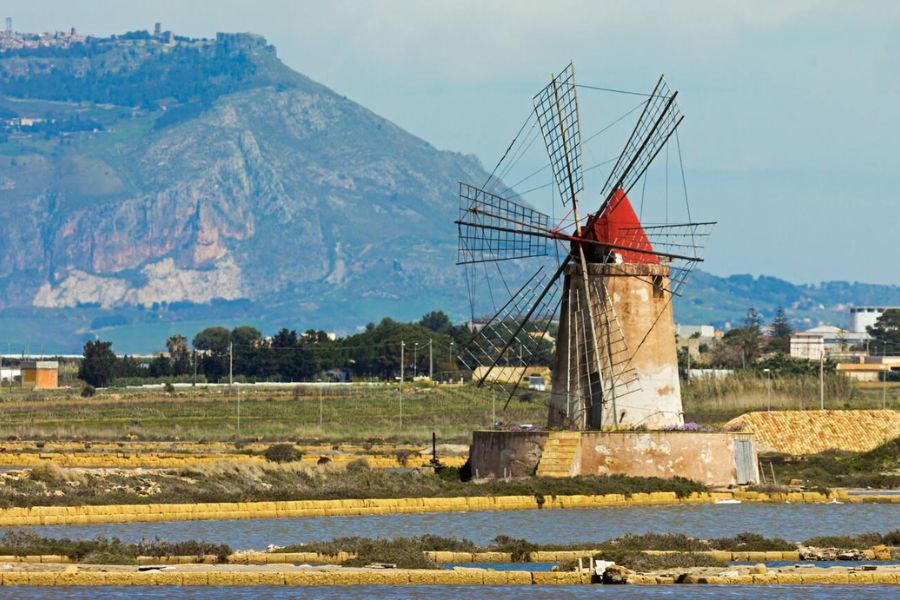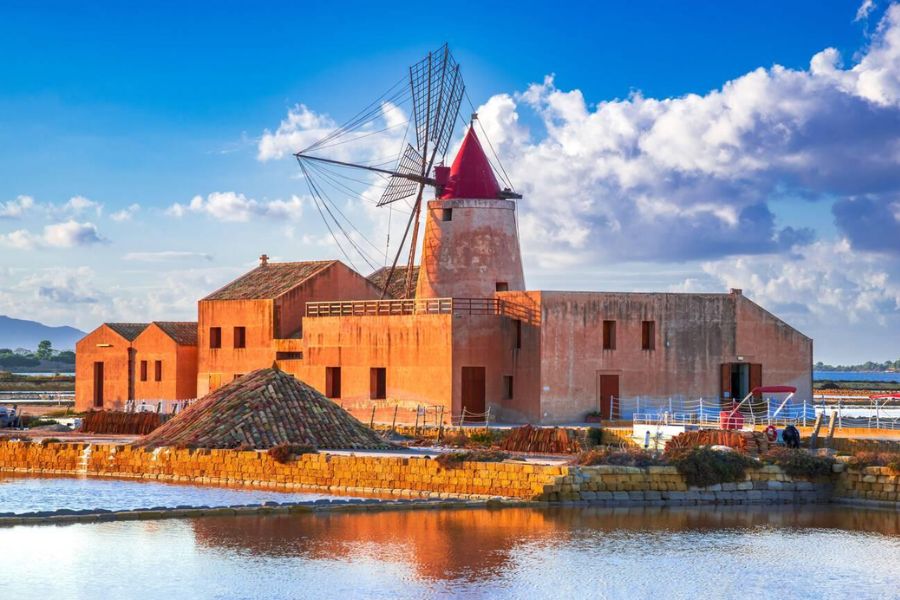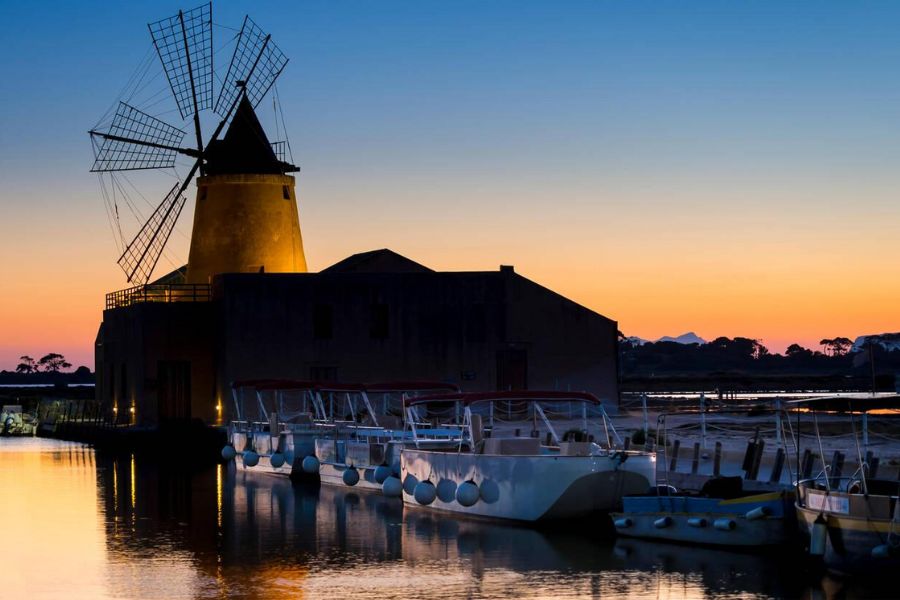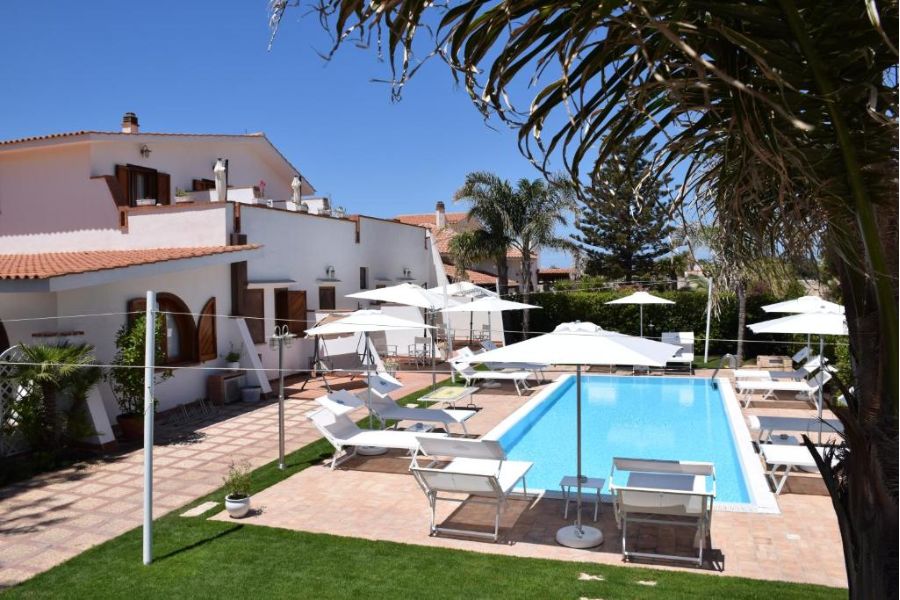As the sun slipped lower over western Sicily, I just stood there, practically glued to the edge of Marsala’s ancient salt lagoons. The water in front of me shifted, slowly trading its clear blue for a wild orange-pink glow that matched the sky.
This magical color change kicks in when certain algae in the shallow water react to the setting sun, creating one of Sicily’s most breathtaking natural phenomena.
The salt flats sprawl across the Marsala Lagoon like a patchwork quilt. Windmills pop up across the landscape, standing as silent witnesses to centuries of salt harvesting tradition.
Pink flamingos wade through the shallows, their feathers almost blending with the water’s rosy shimmer. At the Genna saltwork, I watched salt workers use traditional wooden shovels to harvest salt by hand, just like their ancestors did.
My evening at these lagoons turned out to be more than just a feast for the eyes. The pink waters create a photographer’s dream, and the mounds of harvested salt rise up like little mountains of white gold against the sunset.

If you’re heading to Sicily, try to catch Marsala’s salt flats at sunset. It’s nature’s most impressive color show—a travel experience that feels both timeless and a little magical.
Marsala’s Pink Salt Lagoons: The Science and Magic
The pink hues of Marsala’s salt lagoons pull you in with their mix of science and beauty. These salt-rich waters turn into one of Sicily’s most photogenic spots thanks to a wild combo of microorganisms, high salt, and just the right conditions.
Why the Sea Turns Pink
The striking pink color in Marsala’s salt lagoons comes from microorganisms that love salty environments. Tiny algae and bacteria like Dunaliella salina and Halobacterium make a red-pink pigment called beta-carotene, which protects them from the harsh sun.
When salt levels rise, especially in the hot summer, these organisms bloom and turn the water every shade of pink. Sometimes it’s a soft rose, other times it’s a bold fuchsia, all depending on how salty and sunny it gets.

I’ve noticed the color pops most in the shallow spots where salt crystals line the edges. The white salt against the pink water looks surreal—honestly, it’s hard not to take a hundred photos.
The Unique Nature of Saltwater Ecosystems
Marsala’s salt lagoons create a fragile ecosystem, home to life forms that can handle extremes. Most creatures wouldn’t survive here, but salt-loving (halophilic) species thrive.
You’ll spot:
- Salt-resistant plants hugging the edges
- Specialized microorganisms that turn the water pink
- Flamingos and other birds feeding on the algae (which actually makes them pink, too)
These lagoons have played a role in Sicily’s salt industry since Phoenician times. Salt workers still use ancient methods, piling up salt in pyramid-shaped mounds that dot the view.
Walking here feels like stepping into another world. Salt crunches underfoot, and the breeze brings a mineral tang you won’t find anywhere else.
Seasonal Variations and Best Times to Visit
Marsala’s salt lagoons don’t look the same all year. Summer (June-September) brings the boldest pinks, since the sun evaporates more water and boosts salt levels.
I’ve found late afternoons are the sweet spot. The golden sunset light makes the pinks glow, and the whole place seems to light up from within.
Spring has softer colors and fewer crowds—great for a peaceful walk. Winter mutes the pinks but brings dramatic skies that really set off the landscape.

For the most vivid pinks, come in July or August when salt production is in full swing. You’ll see salt workers busy with the harvest, and the lagoons at their brightest. Don’t forget sunglasses and water—the glare off the salt is no joke!
Immersive Sunset Experiences
As the sun starts to dip, Marsala’s salt lagoons become something out of a dream. There are a few ways to soak up this spectacle.
The Golden Hour Transformation
Evening brings a transformation. The water shifts from blue to gold, then explodes into pink. I just stood there, mouth open, as the sun painted the sky with oranges and purples, all mirrored in the still water.
The salt pans, with their neat lines, stand out against the sky. Harvested salt mounds glow, almost unreal, in the soft light.
Local photographers call this “l’ora magica”—the magic hour. I’ve seen a lot of sunsets, but this one? It’s in a league of its own.
Capturing the Perfect Sunset
Getting the right spot for sunset photos takes a little planning. I usually show up about an hour before sunset and scout along the western edge for the best angles.
For top-notch photos, I’d suggest:
- Bringing a tripod for steady shots
- Using a polarizing filter to make those colors pop
- Finding reflective pools to double the sky’s colors
- Including windmills for a classic touch

The wooden walkways between salt pans are perfect for finding a good view without messing up the ecosystem. I like to mix wide shots with close-ups of the salt crystals catching that sunset glow.
Guided Tours and Local Insights
You’ll find a few local companies running sunset tours of the lagoons. I joined a group led by Marco, a third-generation salt worker who really knew his stuff.
Tours usually cost €25-35 and include:
- Rides from Marsala town
- Stories about the salt-making process
- The best photo spots for sunset
- Sometimes, a tasting of local Marsala wine
Marco pointed out birds I would’ve missed and showed us old tools still in use. It’s the kind of detail you don’t get wandering alone.
Relaxation and Serendipity
Sometimes, the best thing to do is nothing. I found a quiet spot away from the crowds and just watched the colors change for an hour.
The gentle splash of water against the salt pans made it feel almost meditative. There are a few small cafés nearby where you can grab a sunset aperitivo and take it all in.
I chatted with an elderly local who told me how the lagoons have changed over his lifetime. Those random conversations? They stick with you.

Don’t rush. The colors keep shifting for nearly an hour after the sun disappears, and the pinks get deeper before fading into blue.
History and Traditions of Marsala’s Salt Pans
The salt pans stretching between Trapani and Marsala go back over 2,700 years, all the way to the Phoenicians. These ancient operations still run today, producing pure salt without additives or bleaching, sticking to methods passed down for generations.
The Ancient Salt Harvesting Methods
Walking along the edge, I realized the harvesting methods barely changed since ancient times. The shallow seabed is perfect for salt production. Workers let seawater flow into divided basins each spring.
As summer heats up, the water slowly evaporates under the Sicilian sun. Salt crystals start to form, turning the water that wild pink I can’t stop photographing.
Harvesters still use wooden tools to pile up the salt, making those iconic white mounds. It’s honestly amazing how this process has lasted for nearly three thousand years.
Windmills, Landmarks, and Points of Interest
The windmills aren’t just pretty—they used to pump seawater between basins and grind the salt.
Now, many of them are restored as historic sites. The Museum of Salt, set in an old mill, gave me a real sense of the tools and techniques through the ages.
The coastline from Trapani to Marsala is dotted with these windmills. My favorite views came at sunset, when everything glowed gold over the pink water.

Don’t skip the wooden walkways—they let you wander deep into the salt pans without harming the ecosystem.
Ettore and Infersa: Legends of the Lagoons
The best-known part of the Marsala salt pans is Ettore and Infersa. The names come from families who once ran these salt works.
Guides told me the Infersa family came up with new harvesting tricks that spread across the region. Their legacy shows in the careful layout of the basins, all designed to get the most salt.
The Ettore section has some of the best-preserved old buildings. I felt genuinely moved hearing about generations of salt workers who lived right on the lagoon’s little islands.
Some families still in the salt business today can trace their roots back to these legendary folks who shaped Marsala’s salt industry.
Adventures and Activities Around the Salt Lagoons
Marsala’s salt lagoons offer more than just jaw-dropping pink views. I found plenty of activities that turned my visit into a proper Sicilian adventure—think food, nature, and a bit of culture.
Exploring the Surrounding Mediterranean Charms
Leaving the salt pans, I wandered among ancient olive trees that have seen centuries pass by. Their twisted trunks seem to hold secrets.
The nearby Stagnone Nature Reserve is a fantastic backdrop for photos, especially at sunset when the Mediterranean light makes everything glow.
Small fishing villages dot the coast, each with its own vibe. In Mozia, I watched local fishermen haul in the day’s catch using skills passed down through generations.

This area isn’t just about scenery—it’s got a slower pace. Unlike crowded tourist spots, you can actually chat with locals who love sharing stories.
Food, Tea, and Local Culinary Traditions
Salt from these lagoons turns up in loads of local dishes. I tried bread sprinkled with Marsala salt—simple, but unforgettable.
Local Specialties to Try:
- Caponata with local olive oil
- Fresh sea bass with Marsala salt
- Cassatelle (sweet ricotta pastries)
- Marsala wine reductions
Plenty of restaurants offer sunset dinners with views of the salt pans. I loved Trattoria del Sale, where the chef cooks seafood caught that very morning.
A surprise favorite was the herbal tea made with Mediterranean herbs from around the lagoons. Locals add a dash of salt for a unique twist that pairs perfectly with sweet almond treats.
Art, Culture, and Entertainment
The Salt Museum brings the salt workers’ history to life, with tools and old photos showing how little has changed.
Artisans here make salt-inspired art—paintings of the pink water, jewelry with tiny Marsala salt crystals. These make for souvenirs you won’t find anywhere else.
Evenings sometimes bring spontaneous music sessions, with Sicilian folk songs filling the air. One night, I even joined in a dance circle, learning steps that have been done here for generations.

Seasonal festivals celebrate the salt harvest with parades, music, and food stalls. The Festival del Sale in August turns the quiet lagoons into a lively cultural party.
Outdoor Adventures: Cycling and Walking Routes
I rented a bicycle and found it was the perfect way to explore the salt pans. The flat terrain let me ride easily, and the dedicated paths kept me close to the pink waters without harming the ecosystem.
Popular Cycling Routes:
| Route | Distance | Difficulty | Highlights |
|---|---|---|---|
| Lagoon Loop | 8 km | Easy | Full circuit of main salt pans |
| Coastal Path | 12 km | Moderate | Beaches and historical sites |
| Sunset Trail | 5 km | Easy | Best sunset viewing spots |
Walking the trails slowed things down, letting me really take in the wildlife. I spotted flamingos feeding in the shallow waters, their pink feathers almost blending into the lagoon.
If you’re feeling adventurous, you can join a guided kayak tour through the narrow channels between salt pans. I paddled out one morning and saw the lagoons from a perspective most visitors probably miss.
Planning Your Visit to Marsala
Planning a trip to Marsala takes a bit of effort if you want to make the most of the salt lagoons, pink waters, and all that cultural heritage. I’ve gathered some key info to help you sort out where to stay, which tours to pick, and some great day trips from this corner of Sicily.
Accommodation and Where to Stay
I think staying in Marsala’s historic center gives you the best intro, especially if it’s your first time. The old town has a bunch of boutique hotels tucked into restored palazzos, and you don’t have to spend a fortune. My top pick? Hotel Carmine, just a short walk from the main cathedral and all the good restaurants.
Budget travelers have solid options too. B&Bs like Dimora di Charme and Casa Marsala offer clean rooms and homemade breakfasts for around €60-80 per night.

If you want sea views, check out places near the Stagnone Nature Reserve. The Baglio Oneto Resort has incredible sunset views over the salt pans, though it’s definitely pricier.
Most places fill up fast between May and September. I’d say book at least three months ahead if you’re planning a summer trip.
Best Tours: English and Local Options
Taking a guided tour of the salt pans really helped me understand this place. The Marsala Salt Pans Tour (€35) comes with transportation and an English-speaking guide who shows you how they still harvest salt at Genna saltworks.
For something special, I’d recommend the Sunset Lagoon Boat Tour (€45). Cruising through the pink waters as the sun sets is just unforgettable. Operators like Sicily Life Tours and Marsala Discovery get great reviews, and they both offer English guides.
Wine lovers should try a Marsala Wine Tasting Tour (€40) that visits local cellars. Tours usually last 2-4 hours and include pickup from your hotel.
During the busy season, book tours at least a week in advance. Most companies let you reserve online, which makes things easier.
Day Trips to Trapani, Volcanic Islands, and More
Marsala sits in a sweet spot for exploring western Sicily. Trapani is only 30 minutes away by car or bus, and you can wander its medieval streets or hop on a ferry to the Egadi Islands.
The Aeolian Islands are a stretch for a day trip, but it’s doable. I caught an early hydrofoil from Trapani to Stromboli and watched the volcano erupt. It takes about 2.5 hours each way, so you’ll want to start early.
If you want something quieter, drive 45 minutes up to the medieval town of Erice on Mount Erice. The views blew me away.

If you’ve got more time, think about an overnight trip to Pantelleria island for its wild volcanic scenery. Ferries run regularly from Trapani port in summer.
Stories, Inspirations, and Artistic Journeys
The pink salt lagoons of Marsala have fascinated travelers, artists, and storytellers for ages. There’s just something about the place—almost dreamlike—that sparks creativity across cultures and eras.
Travel Journals and Memoirs
While planning my trip, I found myself flipping through old travel journals about Marsala’s salt lagoons. These stories gave me a glimpse into how past visitors felt. One memoir called the sunset over the lagoons “nature’s most perfect watercolor.”
In my hotel’s little library, I stumbled on a novel set in Sicily. The main character found peace in the pink waters, and honestly, I felt the same—a weird mix of calm and awe.
Lots of modern travel writers share their Marsala adventures online, turning their trips into digital journals. I spent hours reading these before I went, picking up tips for the best places and times to visit.
Famous Artists and Narrative Inspirations
Artists have flocked to Marsala’s pink landscape, hoping to catch its strange, otherworldly mood. On my trip, a local guide showed me spots where painters set up their easels over the years.
I heard that Turner sketched the lagoons during his Mediterranean travels, though finding those pieces might take some detective work in museum archives. These days, photographers come year-round—especially at sunset, when the pink turns even more intense.

What surprised me? Writers have finished entire novels while staying near the lagoons. Apparently, the calm atmosphere is perfect for getting creative. A few artists I spoke with said they make a pilgrimage here every year when they start new projects.
Cultural Influences from Turkey, Greece, and Spain
Marsala’s salt harvesting techniques actually connect in some surprising ways to practices in Turkey and Greece. Turkish salt masters, as the story goes, shared their know-how with Sicilian workers ages ago. That kind of exchange shaped the methods people here still use.
Spanish influence pops up in the architecture of the old salt storehouses. When I toured the area, I couldn’t help but notice those arches—they looked a lot like the ones I’d seen wandering around Madrid. The guide pointed out this link, saying Spanish rulers brought their style to Sicily.
Greeks set up some of the first salt works here. Ancient texts, which you can find on Project Gutenberg, actually describe some of these methods. Before coming to Sicily, I spent an evening in Athens and noticed how coastal Greeks relate to their salt pans in much the same way.
All these Mediterranean cultures mixed together and shaped the unique salt harvesting heritage that makes Marsala stand out today.

